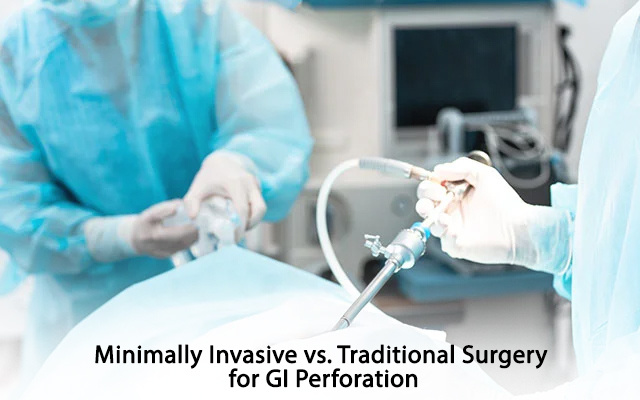Gastrointestinal (GI) perforation is a severe medical condition that happens when a hole starts to form in the walls of the digestive tract, leading to leakage of intestinal contents into the abdominal cavity. This condition can be life-threatening, requiring immediate surgical intervention to repair the perforation and prevent complications such as peritonitis or sepsis.
Traditionally, open surgery has been the go-to method for addressing GI perforations, but with advances in medical technology, minimally invasive surgery (MIS) has emerged as a suitable alternative. Here, we will explore the differences between minimally invasive and traditional GI perforation surgery and how they impact patient outcomes.
Traditional (Open) Surgery for GI Perforation
Open surgery has been the standard treatment for GI perforations for decades. This procedure involves making a large abdominal incision to get full access to the affected area. The surgeon repairs the perforation, cleans the abdominal cavity, and addresses any complications, like infection or damage to nearby tissues.
Benefits of Traditional Surgery
- Direct Access: Open surgery for gastroenterology treatment lets the surgeon have a complete and unobstructed view of the perforated area. This can be beneficial in cases of multiple perforations or complex conditions
- Immediate Action on Complications: In case the surgeon discovers additional problems, like abscesses or significant tissue damage, they can address these issues in the same procedure.
- Widely Available: Traditional surgery does not need any specialized equipment and is widely available in most hospitals.
Disadvantages of Traditional Surgery
- Larger Incisions: The large incisions performed during an open surgery increases the risk of postoperative pain, infection, along with scarring.
- Longer Recovery Time: Patients face a longer hospital stay and recovery period due to the invasive nature of the procedure.
- Higher Risk of Complications: Due to the extent of the surgery, patients are at a higher risk of complications, including hernias and wound infections.
Minimally Invasive Surgery (MIS) for GI Perforation
Minimally invasive surgery, commonly performed via laparoscopy, uses small incisions and specialized instruments to repair the perforation. A laparoscope is inserted through one of the small incisions, providing the surgeon with a magnified view of the abdominal cavity on a screen. The surgeon then uses the other surgical instruments to close the perforation and clean the area.
Benefits of Minimally Invasive Surgery
- Smaller Incisions: MIS for gastroenterology treatment involves much smaller incisions in comparison to open surgery, leading to less postoperative pain, smaller scars, and a lower risk of infection.
- Faster Recovery: Patients undergoing MIS usually experience a shorter hospital stay and a faster return to normal activities.
- Reduced Complication Rate: The minimal trauma to the body during MIS lowers the risk of postoperative complications, including hernias as well as wound infections.
Disadvantages of Minimally Invasive Surgery
- Limited Access: MIS may not be suitable for all cases of GI perforation, especially in cases where the perforation is large or complicated. If there are multiple areas of concern, open surgery might be preferred.
- Need for Expertise: Performing MIS requires specialized training and equipment.
Comparative Outcomes
Several studies have depicted that minimally invasive surgery can result in better outcomes for patients in terms of shorter hospital stays, faster recovery, and reduced postoperative pain. However, the decision to perform MIS versus traditional surgery depends on the specifics of the perforation, the patient’s health, and the resource availability.
In circumstances where immediate and comprehensive access is required, traditional surgery might still be the most preferred option. On the other hand, for smaller perforations, minimally invasive surgery serves as a less traumatic alternative.
To know the most suitable treatment for your condition, reach out to the GI doctors at the best gastroenterology hospital in Dum Dum.
Conclusion
With advancements in laparoscopic techniques, MIS is becoming a preferred option for its advantages in reducing recovery time and postoperative complications. However, traditional GI perforation surgery remains an essential approach for more complex cases.



